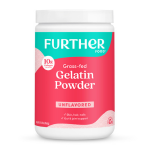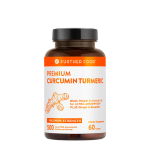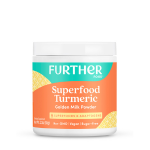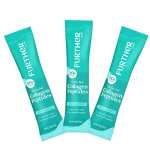 BE HEALTHY EVERY DAY with Further Food Collagen Peptides! Collagen heals your body from the inside out. Learn more here!
Want more? You might also like:
6 Lies the Media Told Me About Being Healthy
Celiac Food Diary: The Gluten Free, Dairy Free Meals this College Student Lives On
After Multiple Diets, I Finally Found A Way To Overcome the Chronic Pain of Fibromyalgia: Find out How
BE HEALTHY EVERY DAY with Further Food Collagen Peptides! Collagen heals your body from the inside out. Learn more here!
Want more? You might also like:
6 Lies the Media Told Me About Being Healthy
Celiac Food Diary: The Gluten Free, Dairy Free Meals this College Student Lives On
After Multiple Diets, I Finally Found A Way To Overcome the Chronic Pain of Fibromyalgia: Find out How
I'm 20 and Can Only Eat 20 Foods - Yeah, College was Tough, But So am I.

For Erica Brahan, her restrictive diet is her disability. Ever since childhood, Erica Brahan has contended with a myriad of health issues. But what began as pain, anger and loneliness, soon turned into a life-changing personal realization. After taking the challenging step of significantly modifying her diet, Erica is now a 20-year-old who can only eat 20 types of foods. But she has finally learned to accept that her diet doesn’t define her-- it’s just a part of her. Read her inspiring story to find out how this college-age woman has learned to come to terms with both her health and herself.
Life has undoubtedly led me down a rough road of health issues. For a long time, I felt like my life and my dreams were slipping away from me. For five long years, I struggled every day. I cried out of physical pain, out of desperation, and simply because I felt isolate in it all. In the early stages, it was easy to dismiss my health issues as purely circumstantial. However, with the gift of hindsight, it is clear that these seemingly minor and unrelated problems were actually foreshadows of bigger things to come.
My health began to spiral out of control when I was 12 years old and began to experience chronic joint inflammation. It was subtle at first, nothing an ankle or knee brace couldn’t fix. By the age of 15 though, I had developed tendonitis in both knees and elbows, multiple fingers, left wrist, and right bicep. To paint a picture: I couldn’t rake leaves for more than five minutes without my forearms burning from the feeling of intense and constant sore muscles. My fingers were stiff, and at times it was a challenge to even unlock my locker or use a pair of scissors. The worst problem? My knees. The sight of stairs could reduce me to tears if I was alone. Despite all of this, I refused to quit softball. Although the sport exasperated the physical pain, I could not give it up.
After a functional medicine doctor advised me to remove all gluten, dairy, corn, soy, and MSG from my diet, I decided to make this tough transition to see if it might improve my symptoms. Although it proved to be a tremendous challenge, desperation and pride were my motivators. Unfortunately, these cumbersome dietary modifications were not enough ease the pain. The chronic inflammation was relentless and manifested itself in additional joints. I wanted to quit more times than I can remember. On top of this, I felt completely alone in the struggle.
Continued dietary changes and attempts at elimination diets over the next two years did very little for the pain associated with my “condition.” However, despite the anger and bitterness I had towards what life had thrown me, I was ready to fully take responsibility for my health in a way I had not before. My next diagnosis provided that opportunity.
Being diagnosed with salicylate sensitivity limited my diet to 20 foods.
The doctor eventually determined when I was 17 that I had a salicylate sensitivity. This resulted in a new diet that was limited to a mere 20 foods containing very low amounts salicylates. This time, however, I embraced the change. Three weeks after removing salicylates from my diet, nearly all the pain stemming from joint inflammation, which lasted five long years, just vanished. With this relief, I felt like an entirely new person and was able to slowly reintroduce these foods into my life. Now, I’m a 20-year old college student navigating how to personally have a healthy and healing lifestyle.
Aside from the salicylate sensitivity and joint inflammation, my journey to wellness has been marked by a plethora of other unfortunate and unpleasant health issues, including candida infections, genetic mutations, poor ability to detox, cystic acne, hypothyroidism, hormone imbalance, and much more. Depending on the perspective, fortunately or unfortunately, these are all closely interrelated.
Presently, I have to avoid the same five original foods and limit my carbohydrate and sugar intake to control and prevent symptoms from flaring and resurfacing. I also have made the difficult decision to stop playing competitive and collegiate softball. After several years of dealing with significant pain in my throwing arm (due to tendonitis -- again), I knew it was time to give up my favorite pastime. My body’s susceptibility to inflammation and its refusal to let it go has become both predictable and impressive. At the end of the day, I have come to recognize and accept that this is my body. This is what it does.
When college started, I was both anxious and ready for a new start.
When I met my seven new roommates freshman year, I was armed with boxes of supplements, food and kitchen supplies. It was a rough beginning. I was insecure about my health issues and crazy restricted diet. Even more, I felt like explaining this involved sharing somewhat personal details of my life with virtual strangers. The problem was that I was still saying, “I am gluten, dairy (and much more) –free”. I had bought into the lie that when you eat differently than others around you, it becomes one of the sole factors of your identity.
The phrase “I am” can be used to describe personality, appearance, location, feelings, and even identity, but the way I eat is not any of those things. It is simply the way I eat, nothing more. I was describing myself the wrong way.
This shift in how I describe myself in relation to diet has helped in the process of becoming more confident in who I am and in my daily life. It may sound trivial, but I now know that I am more than how I eat and what I’ve experienced. The fact that I have struggled with my health since early middle school and eat a very clean diet is only part of what makes me a unique individual. My diet doesn’t define me; it has merely helped on my journey towards wellness.
In fact, I now believe that my life is bigger and fuller because I have learned how to modify my diet to help my body heal. Determining which foods trigger inflammation in has been invaluable and has made me a stronger person. For some, healing from these types of issues can be swift and simple. For others, like myself, it can be challenging and drawn-out. But for nearly everyone though, it is always a challenge because healing involves sacrifice.
It’s all about the journey and what’s in front of you, not necessarily the destination. As of now, my story does not have a complete and happy ending. However, I’ve accepted that I’m in this for the long haul, and that’s okay. It’s the progress I’ve already made in improving my health is what counts. Now, I focus on the positives and avoid dwelling on the negatives. I can walk without pain. I never would have imagined that at 16. I am a college student with a full life ahead of me now. I cherish these blessings. Yes, I continue to trek on my path towards wellness, but every day I choose to help (rather than harm) my body-- now that’s progress.
Learn more about salicylate sensitivity and its effects on your health by reading The Salicylate Handbook.
 BE HEALTHY EVERY DAY with Further Food Collagen Peptides! Collagen heals your body from the inside out. Learn more here!
Want more? You might also like:
6 Lies the Media Told Me About Being Healthy
Celiac Food Diary: The Gluten Free, Dairy Free Meals this College Student Lives On
After Multiple Diets, I Finally Found A Way To Overcome the Chronic Pain of Fibromyalgia: Find out How
BE HEALTHY EVERY DAY with Further Food Collagen Peptides! Collagen heals your body from the inside out. Learn more here!
Want more? You might also like:
6 Lies the Media Told Me About Being Healthy
Celiac Food Diary: The Gluten Free, Dairy Free Meals this College Student Lives On
After Multiple Diets, I Finally Found A Way To Overcome the Chronic Pain of Fibromyalgia: Find out How
 BE HEALTHY EVERY DAY with Further Food Collagen Peptides! Collagen heals your body from the inside out. Learn more here!
Want more? You might also like:
6 Lies the Media Told Me About Being Healthy
Celiac Food Diary: The Gluten Free, Dairy Free Meals this College Student Lives On
After Multiple Diets, I Finally Found A Way To Overcome the Chronic Pain of Fibromyalgia: Find out How
BE HEALTHY EVERY DAY with Further Food Collagen Peptides! Collagen heals your body from the inside out. Learn more here!
Want more? You might also like:
6 Lies the Media Told Me About Being Healthy
Celiac Food Diary: The Gluten Free, Dairy Free Meals this College Student Lives On
After Multiple Diets, I Finally Found A Way To Overcome the Chronic Pain of Fibromyalgia: Find out How
























